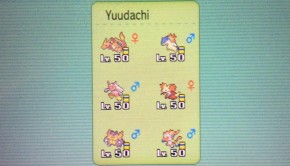Beginner’s Guide to EV Training
If you’ve read our Introduction to Competitive Pokémon, you’re probably looking for a bit more information on EV (Effort Value) Training – the term we use to describe making your Pokémon stronger in specific stats. If you haven’t read that article yet, I recommend you do before proceeding!
Just to recap, EVs are stat point increases that your Pokémon receives every time it gains experience for helping defeat a Pokémon. This means that it gains EVs even if switched out or merely holding EXP Share in the single player campaign, but never gains EVs in multiplayer or in the Battle Subway. Every species of Pokémon in the game gives a set amount of EVs in a specific stat.
This also means that your precious Samurott has been gaining EVs in pretty much every stat without any thought behind it ever since it was a wee little Oshawott. If you’ve ever played an online or western RPG before, you’ll know that this is very, very bad. You want to use EVs to specialize your Pokémon for offensive, defensive, and support purposes. Although there are ways to remove the EVs gained so you can re-distribute the points, it’s a lot more useful to just have fun and not think about all this stuff during the single player campaign and create a new team for multiplayer – maybe with a child of your Samurott if you’re really that attached! This lets you make sure its IVs and Nature are also up to par (and here’s how!).
Grinding for EVs
Yes, that’s right, grinding. Some of you may have already figured it out from earlier, but here’s where I confirm it: to make your Pokémon as strong as they can be, you’ll need to battle and defeat the same Pokémon over and over again until you have the desired amount of EVs.
But still! This sounds like a lot of time! You’d have to defeat 252 Patrats to max out your attack! Thankfully, just about every new game in the series has offered more and more shortcuts so you can field a full team of Pokémon in as little time as possible.
Vitamins
Vitamins can be purchased from a store for a price for 9800 Pokedollars each. Each vitamin increases a specific stat by 10 up to a maximum of 100.
- HP – HP Up
- Attack – Protien
- Defense – Iron
- Special Attack – Calcium
- Special Defense – Zinc
- Speed – Carbos
Vitamins are a good way to get started. If you need less than 100 EVs in any given stat, they make that a breeze! I like using vitamins to get to 100 before starting my actual training. It’s not too hard to earn money in the games after all, and it saves a load of time!
Wings
Wings are much like vitamins: they’re a consumable item you can receive by checking out the shadows of flying Pokémon on the Driftveil and Marvelous bridges in the fifth generation games. They increase the corresponding stat by one and, unlike vitamins, have no cap. Theoretically you could fully EV a Pokémon without doing a single battle this way, but due to their rarity, this isn’t practical.
- HP – Health Wing
- Attack – Muscle Wing
- Defense – Resist Wing
- Special Attack – Genius Wing
- Special Defense – Clever Wing
- Speed – Swift Wing
Macho Brace
When a Pokémon holds this item, the Macho Brace doubles the EVs the Pokémon gets at the cost of halving its speed in battle. This can be very useful for training. Think of yourself as Goku training in a gravity chamber. But if you really want to be like Goku, you’ll want to invest in some power items!
Power Items
The power items are the single most useful items for EV training and it’ll do you well to invest in them early on! When equipped, your Pokémon will have their speed halved much like the Macho Brace, but instead of merely doubling your EV gains, it will add four! So if you defeat a Patrat with a Power item equipped, you’ll get 1 + 4 = 5 EVs! You can also use this to train two stats at once if the Pokémon gives EVs in something your power item isn’t for. This can sometimes get a little hard to keep track of though so most players prefer to concentrate on one stat at a time.
- HP – Power Weight
- Attack – Power Bracer
- Defense – Power Belt
- Special Attack – Power Lens
- Special Defense – Power Band
- Speed – Power Anklet
The Power Items have traditionally been found for 16 BP in the Battle Tower equivalents in each game since their introduction in Diamond and Pearl. However, in Pokémon Black 2 and White 2 you’ll be able to find a few of them in the field.
Pokérus
This is an odd one. Logically you wouldn’t want your Pokémon to become sick… The game wants no part of that though. When a Pokémon gets Pokérus, it will have it for 24 hours at which point it becomes “cured”. By “cured” it means it will retain the effects of Pokérus but will no longer be able to pass it on to others. So what are the effects of Pokérus? It doubles the EVs the Pokémon gains! This effect also stacks on top of whatever item you have equipped.
Unfortunately, getting Pokérus can be a little difficult because it happens randomly after a Wild Pokémon battle. Thankfully, we live in the age of WiFi trading! If you mosey on over to the Requests Thread on our Trading & Breeding board someone will be able to get you one without any problem as long as you ask nicely. All you have to do after that is put it in your party next to the Pokémon you want to infect (that still sounds terrible) and go into a battle. Afterwards, just check the Pokémon’s info to see if it has the Pokérus icon. As soon as this is done, store your original Pokémon with Pokérus in your PC box. It stops the timer that cures it. This way you’ll be able to re-use it in the future to either infect other Pokémon you want to EV train or to create new carriers of the virus to give to other people.
Exp Share
Remember that your Pokémon receives EVs every time it gains experience – not just when it’s the active Pokémon on the field. This means you can keep it in front of your party and switch it out to defeat a strong opponent and still have it gain EVs. Much in the same way, if you want to save your fingers some trouble, you can also use Exp Share and have the Pokémon you’re training gain EVs without having to switch. Just keep in mind that if you use Exp Share, you won’t be able to equip a Power Item. It’s a trade off!
Calculations
So you’ve got all these items, how do they affect your training? Well, let’s look at an example.
We want to train our speed-oriented Garchomp in speed. We decide to do this against Basculin, who gives 2 Speed EVs when knocked out.
- Base: 2 Speed EVs per KO
- Macho Brace: 4 Speed EVs per KO
- Power Weight: 2 Speed EVs and 4 HP EVs per KO
- Power Anklet: 6 Speed EVs per KO
- Pokérus with no item: 4 Speed EVs per KO
- Pokérus with Macho Brace: 8 Speed EVs per KO
- Pokérus with Power Weight: 4 Speed EVs and 8 HP EVs per KO
- Pokérus with Power Anklet: 12 Speed EVs per KO
As you can see, with Pokérus and a power item, you reduce the amount of Pokémon you need to KO to gain EVs by six times! Well worth that initial time investment as it’ll help reduce the time it takes to train all your teams going forward.
I’ve included the results of both the power item for the stat you’re training and the power item you’re not to show you the differences. However, it’s recommended you do one stat at a time to make it easier to keep track of.
Fixing Mistakes
Got EVs where you don’t want them? Don’t worry, Game Freak has thought about this as well. There are berries which will remove 10 EVs every time they’re fed to your Pokémon. This is unaffected by any item or Pokérus and has the additional effect of raising your Pokémon’s happiness stat (used for the attack Return or for certain evolutions).
- HP – Pomeg Berry
- Attack – Kelpsy Berry
- Defense – Qualot Berry
- Special Attack – Hondew Berry
- Special Defense – Grepa Berry
- Speed – Tamato Berry
In the fourth generation of games, you could grow these en masse in the game. However, in the fifth generation, the only way to obtain or grow more of these berries is in the Pokémon Dream World.
An additional quirk for those of you training in one of the fourth generation games (Diamond, Pearl, Platinum, HeartGold, or SoulSilver), if you have more than 100 EVs in the stat you’re trying to lower, the first berry will take it down to 100 EVs regardless of the number it’s at above it. If you lose count, it’s sort of nice as you won’t need to use those vitamins again, but can also be a pain if you just went over your intended target by 2 and need to redo a few EVs. In the fifth generation, it will lower it by 10 EVs regardless of how many EVs you have.
Crunching Numbers
If you remember from your introduction to competitive Pokémon, you can give your Pokémon a total of 510 EVs. Any given stat can have a maximum of 255 EVs. You get a stat point increase every 4 or 8 EVs you add depending on a few different factors. If you want the full, complicated formula and crunch some numbers, Bulbapedia has you covered. However, for now you just need to know that 4 or 8 is the magic number and that 255 isn’t divisible by 4. To optimize your EVs, you want to stop training at 248 or 252 EVs gained and put the rest into another stat. Every point can make a difference (really, just think about it next time you live through an attack with 1 HP and hit back for a KO)!
The easiest way to figure out how many EVs you need is to download Pokémon Online (which you would want to do some quick team testing anyway!) and go into the Team Builder. Input the correct nature and IVs for your Pokémon then move the slider and just watch the stats change as you hit the appropriate thresholds.
Dialing It Back and Moving Forward
At this stage though, you likely won’t be worrying about that. The “252 / 252 / 4” build is very popular for trainers just starting out because it’s simple and can bring decent results. Alternatively, players can also easily find EV builds for different Pokémon by searching through the site and reading tournament reports and team analyses! You’ll see top trainers like 3x World Champion Ray Rizzo, 2x US National Champion Wolfe Glick, and multiple World Championship players explain what their EVs were and why they made the choices they did with them. It’s a great way to learn even for experienced trainers! When you start making your own builds, don’t forget to report back on our forums with your results!










